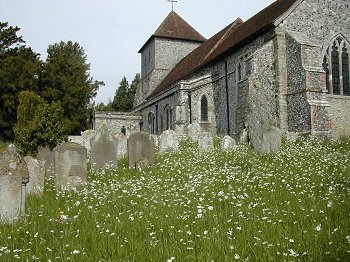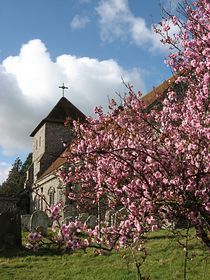| St. Anthony's Church |
 |
|
The churchyard is a wildlife site and is cut once a year.
The Three Churches schedule posted in advance in the
latest issue of the Alkham Newsletter. |
   St Anthony’s is supported by a friendly and welcoming congregation who will be very happy to welcome you should you decide to visit. There is usually an Evening Service on the 1st Sunday of each month at 6.30 in summer, 4.30 in winter; a Eucharist on the 2nd Sunday at 9.30, and a Family Service at 11.00 on the 3rd Sunday. St Anthony’s is very fortunate to have the support of the Friends of St Anthony’s, whose fundraising contributes considerably towards the upkeep of the building and is helping us to secure its future as a living parish church. St Anthony’s Church is a magnificent medieval church dating from around the 12th Century, set on a hillside overlooking the village. It is thought that there was once a pagan temple here, replaced by a church after the arrival of St Augustine. The simple flint exterior of Alkham church hides a remarkable surprise. From the south the building looks similar to many others in the region, but inside it immediately presents its trump card – a north aisle/chapel built in the thirteenth century which contains the finest blank wall arcading in any Kent church. This should be compared with the contemporary chancel arcading at Cooling and Woodchurch – in each designed to emphasise the importance of the (recently rebuilt) chancel. Here it served an altogether different purpose, competing with the nearby commandery of the Knights Hospitallers at Swingfield. At the west end of the nave, filling the tower arch, is a rather heavy but fine, wooden nineteenth century screen. The east window contains some fine nineteenth century glass. St Anthony’s can claim to have been the first carbon-neutral church in Kent, with solar panels installed out of sight on the roof in 2012. The church is usually open to visitors during the day. The churchyard boasts not only some interesting memorials but is managed to support a variety of wildlife native to this part of Kent. |